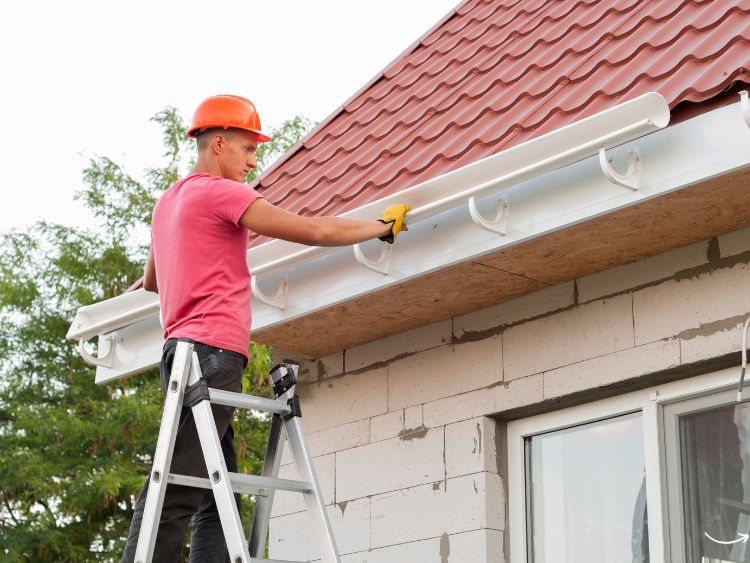Are your gutters looking a little worse for wear? Maybe they’re clogged, sagging, or even leaking. If so, it’s time to talk about gutter cleaning and repair. Ensuring your gutters are in top shape is crucial for protecting your home from water damage. In this article, we’ll delve into everything you need to know about maintaining and repairing your gutters. So, let’s dive in and keep those gutters flowing smoothly!
Why Gutter Maintenance Matters
Gutters play a critical role in directing rainwater away from your home’s foundation. When they’re clogged or damaged, water can overflow, causing a host of problems like:
- Foundation Damage: Excess water can seep into your foundation, leading to cracks and structural issues.
- Roof Damage: Water can back up onto your roof, causing leaks and potential roof damage.
- Landscape Erosion: Overflowing water can erode your landscaping and create unsightly trenches.
- Pest Infestation: Stagnant water in clogged gutters is a breeding ground for pests like mosquitoes.
Maintaining your gutters isn’t just about aesthetics; it’s about protecting your home and property.
The Basics of Gutter Cleaning
Cleaning your gutters might seem like a daunting task, but with the right approach, it’s manageable. Here’s a step-by-step guide:
- Gather Your Supplies: You’ll need a sturdy ladder, gloves, a scoop or trowel, a bucket or trash bag, and a garden hose.
- Safety First: Ensure your ladder is stable and positioned on level ground. Consider using a ladder stabilizer for added safety.
- Remove Debris: Using your scoop or trowel, remove leaves, twigs, and other debris from the gutters. Place the debris into your bucket or trash bag.
- Flush the Gutters: Once the debris is removed, use a garden hose to flush out any remaining dirt. This will also help you identify any leaks or blockages.
- Check for Proper Flow: Ensure water flows freely through the downspouts. If there are blockages, you might need to use a plumber’s snake to clear them.
Gutter Repair Tips
Gutters can suffer from various issues, including leaks, sagging, and rust. Here’s how to tackle common gutter problems:
Fixing Leaks
- Identify the Leak: Look for visible holes or cracks in your gutters.
- Clean the Area: Ensure the area around the leak is clean and dry.
- Apply Sealant: Use a gutter sealant to cover the hole or crack. For larger holes, you might need to use a patch along with the sealant.
- Allow to Dry: Give the sealant ample time to dry before testing with water.
Addressing Sagging Gutters
- Inspect the Hangers: Gutters sag when their hangers become loose or damaged.
- Tighten or Replace Hangers: Tighten any loose hangers with a screwdriver. If they’re damaged, replace them with new ones.
- Add Additional Hangers: If your gutters still sag, consider adding extra hangers for additional support.
Dealing with Rust
- Scrub the Rust: Use a wire brush to scrub away rust from the affected areas.
- Apply Rust Inhibitor: After removing the rust, apply a rust inhibitor to prevent future rusting.
- Paint the Gutters: For a more permanent solution, consider painting your gutters with a rust-resistant paint.
Choosing the Right Gutter System
If your gutters are beyond repair, it might be time to consider replacing them. Here are some popular gutter options:
K-Style Gutters
K-style gutters are the most common type of gutter. They’re known for their decorative shape, which resembles crown molding. These gutters are durable and can handle a large volume of water.
Half-Round Gutters
Half-round gutters are often found on older or historic homes. They have a semi-circular shape and are known for their aesthetic appeal. However, they don’t handle as much water as K-style gutters.
Box Gutters
Box gutters are typically used on commercial buildings. They’re built into the roof structure and can handle significant water flow. They’re ideal for large roofs with high water runoff.
FAQs About Gutter Cleaning and Repair
How often should I clean my gutters?
Ideally, you should clean your gutters at least twice a year—once in the spring and once in the fall. If you have trees near your home, you might need to clean them more frequently.
Can I clean my gutters myself?
Yes, cleaning your gutters is a DIY-friendly task if you have the right tools and take necessary safety precautions. However, if you’re uncomfortable with heights or have a large home, consider hiring a professional.
What are the signs that my gutters need repair?
Look for signs like visible cracks, rust, sagging, water stains on your home’s exterior, and water pooling around the foundation. These indicate that your gutters might need repair.
How much does gutter repair cost?
The cost of gutter repair varies depending on the extent of the damage and your location. On average, homeowners spend between $150 and $350 on gutter repairs.
Can I prevent my gutters from getting clogged?
Yes, you can install gutter guards or screens to prevent debris from entering your gutters. Regular maintenance and trimming trees near your home can also help keep your gutters clear.
Conclusion
Gutter cleaning and repair might not be the most glamorous home maintenance tasks, but they are essential for protecting your home from water damage. By following the steps and tips outlined in this guide, you can ensure your gutters remain in good working condition. Remember, regular maintenance is key to avoiding costly repairs down the line.
Authoritative Links
Maintaining clean and functional gutters is crucial for your home’s health. Don’t let minor issues turn into major problems. Stay proactive, and your home will thank you!







